Sveva D’Antonio was born in Naples in 1989, graduated in art history and conservation of the artistic heritage in 2013 with a thesis entitled “Looking Godard”, focused on the possibility of exhibiting cinema in museums. After having carried out various internships at some galleries in Naples and Brussels, in 2016 she began working, first as an assistant and then as a partner, at the Laveronica gallery in Modica, which offers a socially and politically engaged art. Since 2014 she has dedicated herself together with her husband Francesco to the development and promotion of the Taurisano Collection, a private collection of contemporary art based in Naples started in the 1970s by her father-in-law Paolo Taurisano.
Together with her we talked about how she dealt with the past period, her role as a collector, future projects, the evolution and history of the Taurisano collection.
Valeria Fortuna: How did you deal with the lockdown and what changes or innovations have arisen from this period?
Sveva D’Antonio: We usually try to travel at least once a year to get an opinion on the young artists who are starting to work. In March we had a lot of studio visits planned in New York, but we could hardly do any. We were in New York for three, four days, after which we were forced to return to Italy, because we were afraid of being stuck there. However, we have decided to carry out these visits in a virtual way. But instead of doing them with Skype or Zoom, we decided to share them with those who follow us, with our public, and in general with all contemporary art lovers. And so the “We Care” series was born, whose goal is first of all to give support to artists by offering them, through our Instagram profile, the opportunity to show what works they were doing at that time and also to externalize their difficulties. As collectors, we think it is a great responsibility to support artists, in an increasingly active way and also all the other players in the system, because we always talk about the art system and not about isolated entities. So we asked curators, directors of museums and art fairs, collectors, directors of private foundations what they were doing in this very particular condition: all were super participatory, they gave ideas that in my opinion were fundamental, especially for artists. I must say that in this period the centrality of the artist has been rediscovered without unnecessary corollaries and that this has unleashed their creativity. Even for fairs, viewing rooms were, I would not say the simplest tool, because many of these platforms work thanks to very complex technologies, but more immediate to convey a three-dimensional view of the works. During the pandemic, however, we felt the lack of a direct relationship with the work, because we collect and then make the works stay with us and to maintain a relationship of everyday life and spatiality with them. And then there was no relationship with the artist, the chatter, the explanation, the mediation, so we continued to buy only artists we already knew before the isolation. In my opinion, in this general trend, a fair that has done something truly alternative is Art-O-Rama, in Marseille, which takes place every year on the last weekend of August and which this year had to coincide with Manifesta, from which a great participation was really expected. Unfortunately, the fair, where we had also established the “Because of many suns” award, could not be done and so we decided to make a series of video capsules, in which we interviewed various actors of the art system. In addition to me, the director of the award Carolina Ciuti, the director of the fair Jèrome Pantalacci, the curator Tiago de Abreu Pinto, the LambdaLambdaLambda gallery participated; in a couple of days the latest content will be published, the one by the Romanian collective Apparatus22, inventor of the name of the award. We have reinvented ourselves with regard to the award and they have completely reinvented the idea of using the online fair, proposing a salon immateriél, an online exhibition only for intangible works, such as written texts or audio contributions. All the artists, with the galleries prepared contributions to be uploaded online, each gallery had its own link.
Valeria Fortuna: How did you relate to this digital change, from the point of view of your role as a collector? Do you agree with viewing the works on online digital platforms or do you think a live view of the works is more suitable?
Sveva D’Antonio: I think that the work must always be really seen. Certainly digital in the future will be definitively integrated into our lives and therefore also into the practice of collecting. It is something that must go hand in hand, it cannot completely replace the true enjoyment of works of art. Then the use of additional content can be a useful tool to enrich the knowledge of an artist or a work. But then you must also see the work live, you must restore the relationship with the space that we have lost in this last period.
Valeria Fortuna: Has anything changed in the other projects you are carrying out?
Sveva D’Antonio: Because of many suns is very important for us, so, as I said before, the last contribution will be published in a few days, that of the artists of the Romanian collective Apparatus22 which closes this “digital” season. In August 2021, there will be the actual award ceremony at the Art-O-Rama fair in Marseille: beyond the acquisition of the artist’s work, there will be the commission of a text, on the practice of the chosen artist. It will be something that will last over time, will not have an expiration date but will, hopefully, accompany the artist throughout his career.
Valeria Fortuna: What are the emotions that manage to involve you when you decide to acquire a work or to meet a new artist?
Sveva D’Antonio: In general, the works you buy are linked to emotional states in your life or certain personal conditions. What then triggers the spark is a n art work that leaves you a question mark, that somehow tests you, that challenges you, that communicates or tells you something you don’t know. Finding something unknown and different from you is a fascinating experience, which then pushes you to go further and deepen your knowledge of the artist. It is somehow making up for the shortcomings we have, whether it is knowledge, emotions, feelings. Another thing we are always looking for is the possibility of dreaming through a work of art that makes you reflect on what you are experiencing now, making you imagine something that is better, that is more beautiful, in a romantic way. The reasons that drive us to buy are the challenge and the desire to dream.
Valeria Fortuna: Which young artists are part of the collection and which were acquired during the lockdown period?
Sveva D’Antonio: We recently acquired Joy Labinjo, a young artist of whom we have a beautiful piece. We bought Zoè Bluem, a very young Californian painter. There is a young Neapolitan artist, Marco Pio Mucci, of whom we bought five drawings from a very young gallery, Luca Castiglioni in Milan. We have tried to support many artists in the last period, also trying to involve and sensitize other collectors. Being a collector, as I said before, is a great responsibility.
Valeria Fortuna: Would you tell me the history and evolution of the collection?
Sveva D’Antonio: The collection was born with my husband’s father, Paolo Taurisano, initially in relation to the Campania region, so we are talking about the artists of the 70s, the transavantgarde, the nuclear movement, all artists who at the time were politically and socially engaged. The father collected for many years and then stopped. My husband and I took over ten years ago, starting to collect artists who somehow are not afraid of losing this aura of eternity, which the artist always wants to have. Artists who actually talk about very concerse things, everyday topics that are also quite uncomfortable. Then we ranged on artists of our generation, with whom we could have a personal relationship of dialogue and communication. And then we also have many artists linked to more material and formal aspects of art, who deal with different types of themes. We make no distinction as to the medium used, in the collection we have painting, installation, audio installations, drawings. The medium must be a tool to communicate a message. We also have a series of videos in the collection to which we are very fond of, even if video is still a difficult medium for collectors, we are interested when it is not a simple documentation of an event or a didactic representation. This is the evolution of the collection, which remains private: we have decided to walk on our own legs, so not to seek public funds, not to turn ourselves into a foundation even if our spirit, our will to be public in reality is already expressed in our activities. Even our own house is always open to curators, journalists and artists. Now that we have reached 400 works, we think that the future of the collection will be to form a trust to guarantee its integrity even after us because we will never know if our children or our grandchildren will have the same passion or the same commitment towards the works that inhabit our home.
Valeria Fortuna: Where did your interest in contemporary art come from?
Sveva D’Antonio: In Naples we are surrounded by beauty and a truly immeasurable artistic heritage. For the entire generation of the late 1980s, of which I am a part, it is normal that we started with the paintings of the 1600s, with Ribera with Rubens, with the Neapolitan Baroque and Rococo. Then each of us took a different path. I have always been curious about current events, but I discovered contemporary art during the university years, and certainly the meeting with my husband cemented everything. Together we started visiting the galleries: there is a crazy tradition of galleries (such as Lia Rumma or Alfonso Artiaco) who brought contemporary art to Naples with Andy Warhol and Joseph Beuys. Even behind the contemporary there is a very complex story that needs to be studied.
Valeria Fortuna: Is there an artist or a work that particularly struck you during your studies, that stimulated you to follow this path?
Sveva D’Antonio: An artist who somewhat marked my passage, from which I have now distanced myself, was Marina Abramovic’. In particular, the performance “The artist is present”, where the trappings of art were completely demolished, there was no longer a boundary between artist and public, the artist was present and gave herself completely in her corporeality to anyone. It’s a punch in the face, so for me it was a very violent performance at the time. We must always try to support female artists! At that time the super stars were male artists, even today the number of female artists exhibited in museums is slowly improving but we are always at ridiculous percentages, women are never valued enough. I would also quote a work by Francis Alys, a video where men should move mountains but in reality these mountains are made of sand and they continue to dig in vain. Here the artist expresses the impossibility, the impotence of man with respect to nature, with respect to the great things that we do not decide, but also the strength of community and cooperation. Art probably represents a tool to combat what we cannot control, a way to have access to information or alternative communication, which the media often do not give us.
Valeria Fortuna: Do you have any future projects related to both digital and the return to galleries?
Sveva D’Antonio: We have a “dream in the drawer”: we have many works, which due to their size cannot be installed in a house. In 2021 we would like to have the opportunity to exhibit some artists in museum or public contexts in order to open the collection to the public. Our priorities are multiple, because we always try to help artists in the production of new exhibitions and new works. We are always ready to give advice, we try to be active, simply the role of final buyer of the artifact is not enough, we love to be involved in the process of a job.
Valeria Fortuna
Info:
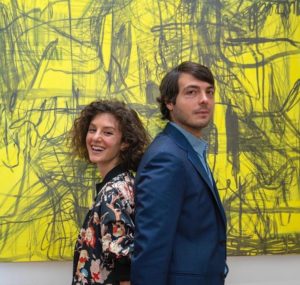 Portrait of Sveva D’Antonio and Francesco Taurisano
Portrait of Sveva D’Antonio and Francesco Taurisano
 Michael E. Smith, Untitled, 2018. Cell phone, laser, LSD
Michael E. Smith, Untitled, 2018. Cell phone, laser, LSD
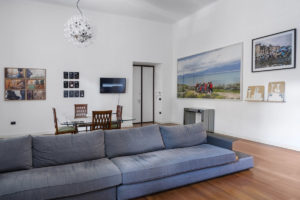 Casa Taurisano, 2020, installation view, ph. Maurizio Esposito
Casa Taurisano, 2020, installation view, ph. Maurizio Esposito
 Casa Taurisano, 2020, installation view, ph. Maurizio Esposito
Casa Taurisano, 2020, installation view, ph. Maurizio Esposito
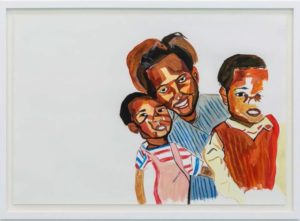 Joy Labinjo, Mum, Toni and I, 2019. Acrylic and watercolour paint on paper, cm 67.5 x 96.6
Joy Labinjo, Mum, Toni and I, 2019. Acrylic and watercolour paint on paper, cm 67.5 x 96.6
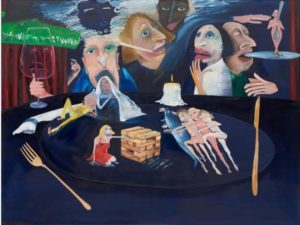 Mary Stephenson, A Fine Balance, 2018. Oil on canvas, cm 120 x 160
Mary Stephenson, A Fine Balance, 2018. Oil on canvas, cm 120 x 160
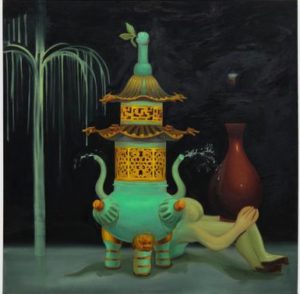 Dominique Fung, What’s Left Behind, 2020. Oil on canvas, cm 152.4 x 152.4
Dominique Fung, What’s Left Behind, 2020. Oil on canvas, cm 152.4 x 152.4
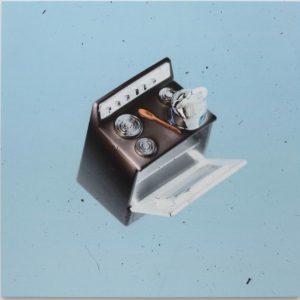 Norma Jeane, flight#8, 2000-2019. Printing on fine art cotton canvas, cm 140 x 137.84
Norma Jeane, flight#8, 2000-2019. Printing on fine art cotton canvas, cm 140 x 137.84
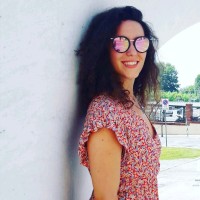
Valeria Fortuna, a student in History of Art and Cultural Heritage, deals with enhancing art and bringing young people closer to it through advice on exhibitions to see and curiosities about artists. She loves contemporary art in all its aspects for the emotions it manages to convey and for the language it uses, which is constantly evolving.




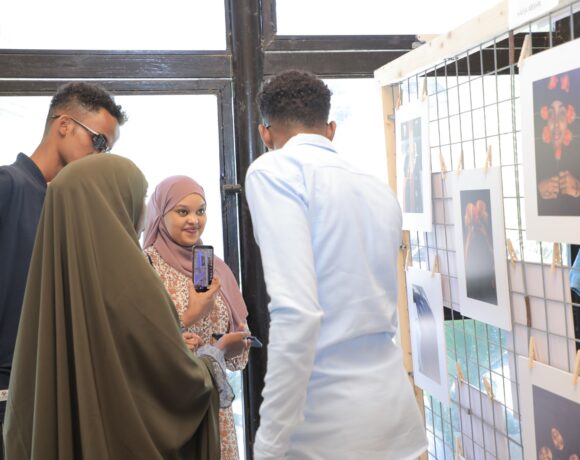

NO COMMENT